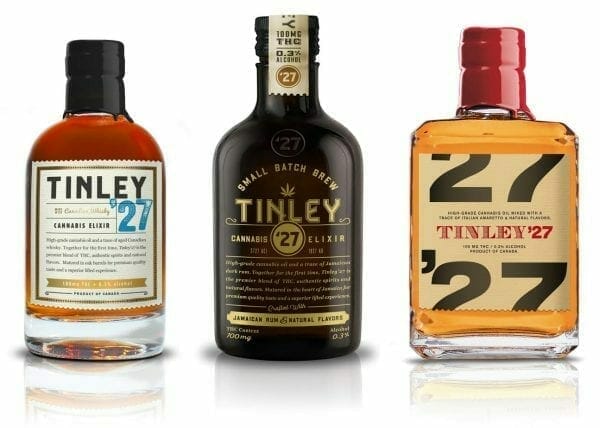I’m not usually a big fan of the beverage business, because getting a product onto store shelves is a ruthless game for the sort of scoundrels that, a hundred years ago, would have been selling swamp real estate to seniors. But if you can make it work, there are undeniable fortunes to be made. Red Bull sold 6 billion cans last year, and is valued at over $5 billion. Not bad for a drink that tastes like kerosene.
Tinley is not Red Bull, but it has already surpassed 50 stores in its first month and may have an idea that can elevate it to a far higher valuation than its current $4.2 million. More on that in a moment.
Before we get to the kicker, let’s back it up a little and see where Tinley came from. Originally, the company set out last year to produce hemp stalk-based CBD functional nutrition drinks. Which, yes, I know sounds about as appealing as cow pat salad, but technology is a wonderful thing and, frankly, so too is the nutritional makeup of hemp stalk.
For those who want the health benefit of the CBD found in high-quality weed but don’t want to smoke, or don’t have a license to buy bud, or fear they may get drug-tested at work, hemp stalk has ample CBD presence without the problem of being classified in the US as a class 1 drug. Plus the oils and vapes are being sold in all 50 states in regular stores, rather than being limited to dispensaries in the 4-5 legal rec states.
In the old days, hemp and cannabis oil were the basic medicines for just about everything. Then we got all reefer madness-y and let those ingredients become illegal and so here comes Tinley doing what EVERYONE did back in the day, making hemp a nationwide nutritional beverage again, instead of just something Woody Harrelson uses to make chinos. Though they’re doing it with CBD-rich hemp stalk rather than from hemp seed, which is what virtually all other hemp food and beverage products are made from. Hemp seed may be a very healthy ingredient for its own reasons, but unfortunately for consumers guzzling these products, hemp seed doesn’t contain CBDs like Hemplify does.
Problem: Hemp tastes pretty hempy.
Solution: This product comes in two flavours – tropical punch and berry passion, rather than the old flavours our grandparents enjoyed, commonly known as ‘molasses puree’ and ‘roadkill surprise.’
Using some advanced wizardry and food tech, Hemplify doesn’t taste like garden waste, because it infuses oil-based ingredients into a water-based drink with tech that creates micelles, which preserve the structure of the hemp oil as it moves through your system, tricking your gut into absorbing more of it into the bloodstream. Translated: The good stuff does more good, and doesn’t taste like swamp.
According to the company, in taste tests in California, consumers have been constantly surprised that Hemplify tastes more like a quality tasty beverage and less like a nutritional supplement.
Added bonus: It’s fortified with omega 3, vitamins and electrolyte potassium, it has no sugar, no GMOs, no gluten, and is vegan, which is completely on-trends with health-oriented consumers that are increasingly steering away from the pop aisle.
And when California votes to make marijuana fully legal on November 8, it’ll be a simple switch to turn Hemplify into BongHitify or BlowMyMindify or THCForDaysify. This makes Tinley one of only two Canadian-listed cannabis companies with a presence in the state, alongside Maple Leaf Grow World (MGW.V), and therefore a really strong option for playing the November ballot initiative.
But don’t let me come across as being all advertorial here: It’s worth repeating, retail is a rough business. You’ve got to secure bottling facilities, build sales networks, market your brand, make a brand that people will connect to and relate with and want to take home. You’ve got to lay out millions for all that sh..
Wait.. I’m getting a call here from Hemplify that says Tinley outsources all production, which adds a few points to the expenses end of the balance sheet, but removes the multi-million dollar set-up bill that startup competitors face as a barrier to entry.
Tinley doesn’t have all its cash tied up in a factory, or is spending hundreds of thousands on a sales force. Its sales network is a 20+ person third-party group that goes out to a multitude of convenience stores, health food stores, dispensaries and the like, and takes a commission. The product is bottled the same way Coca Cola does it, by licensing out that work to others who’ve already made their multi-million dollar facility investments. Design is outsourced. Branding is outsourced. And staff-wise? Ultra small. Plus on the branding side, they’ve started to delve into the minor celebrity world with Cody Simpson, Post Malone, and others holding the drink on their social feeds.
A photo posted by Gina Itor (@gina_itor) on
What this does is lessen risk. On the flipside, it also clips margin, meaning Tinley makes less per bottle sold – for now. But they’re okay with that in the early stages, as the margins are high to begin with and the product is still being tweaked and improved.
That means small production runs keep costs down while allowing them to run tests in various markets, in various chain stores, and get instant feedback that can be used to tweak further.
Wanna try it? Buy some on Amazon, where you can also find customer reviews.
So this is all a good thing. What’s better?
Boozify.
Imagine, if you will, an alcoholic beverage that tastes like a Friday afternoon summer patio drinky, but instead of getting you drunk, it gets you gently stoned. That’s phase II of Tinley’s big plan, in which they’re putting out three products – a Canadian whiskey, an Amaretto, and a Jamaican rum, that are de-alcoholized and infused with THC. It’ll taste like your favourite drink, and is in fact made from the actual spirits, but it’ll get you high instead of drunk.
This is great news for those who endure hangovers badly, or have problems with over-drinking, or would (like me) be happy to get stoned occasionally without actually smoking, and in polite company.
Tinley just released the news of this move and the stock price flew on the back of it. Admittedly, all weed stocks are on the move right now, but Tinley is hitting the ground with a newer, bigger plan at EXACTLY the right moment to take advantage.
A week ago, you could have snapped up this stock for $0.06 a throw. Today? $0.115. That’s a near double, and the story isn’t even really out there yet.
I talked to Tinley boss Jeff Maser yesterday, while the weed world was on an absolute tear, and I could barely hear him for the phones ringing in the background. Maser tells me brokers are beating on his door, looking to get involved with the new plans, but that he’s not getting carried away.
“We’re currently doing test runs at a large convenience store chain and we’ve been picked up in 50 stores in 6 states, plus 2 major web stores, all in our first month,” he said.
He added, “We believe the de-alcoholized drinks are a game-changer. Nobody enjoys someone busting out a joint at dinner, but now you could enjoy a drink with your friends and get a comfortable high instead of getting your drunk on.”
Maser’s right. Even just on novelty value, you’d have to think everyone is going to try that at least once. When the state votes to go recreational in November, Tinley will have their finger on the ‘launch’ button.
A photo posted by Hemplify (@hemplify) on
Yesterday, in my mega medical marijuana update, I said Tinley was a wait and see. Today, with the stock dipping a cent on profit taking, and the expanded info on future plans, this might be the right time to take a piece.
— Chris Parry
FULL DISCLOSURE: I’ve bought some Tinley stock.



Why not wait the financing you are expecting!?
Appears they don’t need one.
Hello, nutritional high, and ags are also American marijuana related companies that trade on the Canadian markets.
Chris, in at .11 last week. Cheers on this one.
hi chris
this current nonbrokered private placement that posted today
do you consider this a negative?
and in the short term because they are doubling the amount of shares outstanding would that also cause a drop and share price by 50%?
thanks!
My view of a $0.40 stock running a $0.17 PP with $0.25 warrants is, you drop everything and acquire as much of that PP as they’ll let you have.
That’s what I’m doing. Obvs, do your own DD etc.. 🙂
Hi Chris, what are your thoughts on the 17cent PP which was announced today?